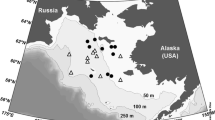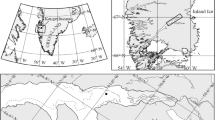Abstract
A mesocosm experiment (enclosure volume 220 l) was designed such that sea ice inhabited by Arctic Sea ice organisms was formed and maintained under natural conditions at 66°N in Rovaniemi, Finland. The experiment was run from natural freezing in December 1994 to melting in April 1995. The ice was inhabited by diatoms, chlorophyceae, heterotrophic flagellates, ciliates, nematodes and turbellarians. Biomass in the ice, expressed as Chlorophyll a concentration, was 20–110 μg l−1; total cell densities varied from 5 × 106 to 35 × 106 cells l−1. Amongst phototrophic organisms, a succession from a flagellate-dominated community (Chlamydomonas sp.) to a multi-species diatom-dominated community was observed. Typical Arctic species such as Nitzschia frigida and Melosira arctica were present in the ice. Bacterial concentration varied between 2 × 108 and 7 × 108 cells l−1. At least two trophic levels were present in the ice.
Similar content being viewed by others
Author information
Authors and Affiliations
Additional information
Received: 3 April 1997 / Accepted: 9 September 1997
Rights and permissions
About this article
Cite this article
Weissenberger, J. Arctic Sea ice biota: design and evaluation of a mesocosm experiment. Polar Biol 19, 151–159 (1998). https://doi.org/10.1007/s003000050228
Issue Date:
DOI: https://doi.org/10.1007/s003000050228




